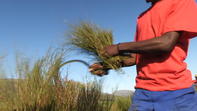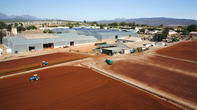The growing and production of the aromatic, caffeine-free and healthy rooibos tea is confined to the mountainous regions, and specifically the Cederberg area, of the Western Cape Province of South Africa.

The Rooibos Plant
Rooibos, Aspalathus linearis, is part of the legume family and grows as shrubs between 1 - 2 m high in the wild. Depending on the age and growing conditions, cultivated rooibos grows from 0.5 m to 1.5 m in height, and prefers well-drained sandy soil with a low pH.
With a deep taproot, rooibos tea plants are well-adapted to harsh, dry conditions and can thrive in temperatures ranging from 0℃ to over 45℃. Rooibos requires a winter rainfall of between 180 mm to 500 mm per year - no irrigation is used.
During October the plants are covered with small, yellow flowers, that produce tiny, hard-shelled seeds, which are collected by sifting the sand around the plants. The seeds need to be mechanically treated to increase the germination rate. This is done by scrubbing the seeds with mechanical scourers, which can increase the germination potential from 30% to about 95%.
Rooibos Tea Production Process

Cultivated rooibos seeds are planted in seedbeds in the summer months of February and March and transplanted into rows in plantations during winter. After 18 months, rooibos can be annually harvested by cutting the top 50 cm of the shrubs. These cuttings are bound in bundles and mechanically cut into a uniform length.
Before fermentation, the cuttings are bruised and then left in heaps to ferment. During this process of enzymatic oxidation, the tea changes from green to red-brown and develops its distinctive sweet rooibos aroma. After fermentation, the cuttings are spread out in large drying yards to be sun-dried.
Depending on temperature and humidity, the fermentation and drying process takes one to two days. Sometimes, it can finish fermenting on the same day as it was spreadout. Under ideal circumstances, rooibos can be dried to less than 10% moisture content (shelf-stable conditions) by the next day.
For the production of green rooibos tea, the fermentation process is skipped and the cuttings are dried directly after chopping. The cuttings are passed through a heated fluid-bed dryer – this process takes approximately 20 minutes.
Green (unfermented) rooibos tea has higher levels of antioxidants, while fermented rooibos tea has a sweeter taste.
After processing, all final products are sterilised and sent to a laboratory for micro-analysis.
Sorting, Grading and Packaging Rooibos Tea
Rooibos tea cuttings are graded according to length, colour, flavour and aroma.
The finished rooibos tea is weighed and packed in paper bags, bulk bags or vacuum boxes, which are then automatically palletised and stretch-wrapped.
By Marinda Louw and Rooibos Ltd.